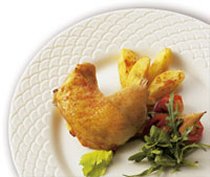Infections in poultry with paratyphoid
Salmonellae
Chickens are usually asymptomatic carriers of paratyphoid Salmonella bacteria. The organisms colonise the intestinal tract and sometimes the reproductive tract of carrier birds. This can lead to contamination of carcasses and eggs meant for human consumption.
Clinical signs in poultry
- Clinical signs uncommon in poultry.
- Usually seen in birds younger than two weeks of age
- Non specific – listless, diarrhea, fluffed up feathers.
- Signs similar for all serotypes
Asymptomatic carriers
- Infected poultry that are older than 4 weeks are usually free from Salmonella bacteria within 60 days.
- A small percentage of infected birds may excrete Salmonellas continuously or intermittently.
- Excretion can be reactivated by stress.
Salmonella serotypes causing food poisoning from poultry products
The most prevalent serotypes are Salmonella Enteritidis and Salmonella Typhimurium. Other serotypes such as Salmonella Paratyphi B java, S. Agona and S. Heidelberg are being isolated more frequently as a cause of food poisoning from chickens.
For a complete overview of the global prevalence of the different Salmonella serotypes in chickens and humans see Epidemiology
Transmission of Salmonella bacteria
Salmonella Enteritidis:
- May be transmitted vertically.
- Colonizes the reproductive tract of the hen. Eggs are infected before the shell is formed.
- Chicks hatching from Salmonella-positive eggs spread the bacteria laterally.
Control and Treatment
- Treatment with antibacterials:
- Reduces mortality and morbidity.
- Antibiotic resistance is possible.
- Sensitivity of the organism should be checked first.
- After treatment a number of birds may become long-term carriers of Salmonella.
Effective Salmonella control requires an integrated approach of:
- Monitoring.
- Good hygiene.
- Vaccination.

Prevent food poisoning?
